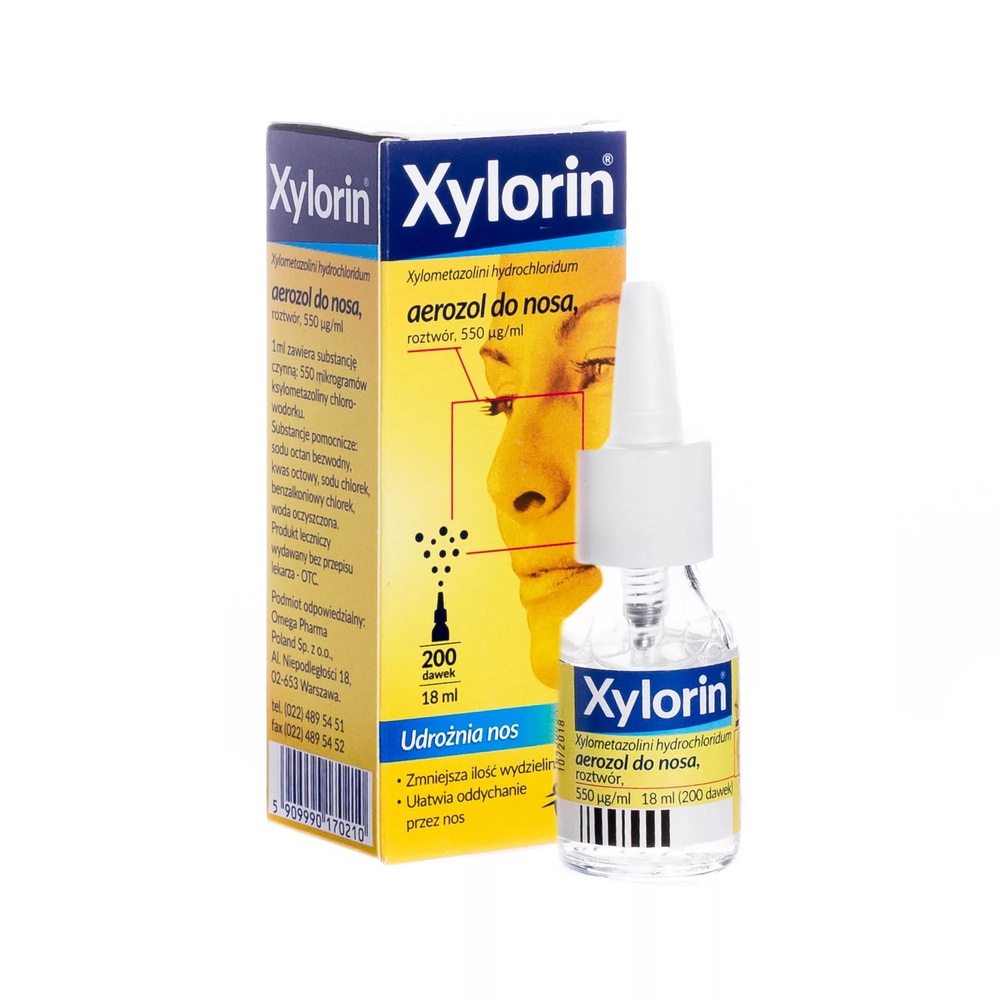

Xilorin

Ask a doctor about a prescription for Xilorin

How to use Xilorin
LEAFLET INCLUDED IN THE PACKAGE: INFORMATION FOR THE USER
Xylorin, 550 μg/ml, nasal spray, solution
Xylometazoline hydrochloride
Read the leaflet carefully before using the medicine, as it contains important information for the patient.
This medicine should always be used exactly as described in this leaflet for the patient or as advised by a doctor or pharmacist.
- This leaflet should be kept in case it needs to be read again.
- If advice or additional information is needed, a pharmacist should be consulted.
- If the patient experiences any side effects, including those not listed in this leaflet, they should inform their doctor or pharmacist. See section 4.
- If after 5 days (in children aged 6-12) or 7 days (in adolescents over 12 years and adults) there is no improvement or the patient feels worse, they should consult a doctor.
Table of contents of the leaflet
- 1. What is Xylorin and what is it used for
- 2. Important information before using Xylorin
- 3. How to use Xylorin
- 4. Possible side effects
- 5. How to store Xylorin
- 6. Contents of the package and other information
1. What is Xylorin and what is it used for
Xylorin nasal spray contains xylometazoline hydrochloride. The medicine causes constriction of the small blood vessels in the nose, reducing swelling and congestion of the nasal mucosa. This leads to the opening of the nasal passages, making it easier to breathe through the nose and reducing the amount of secretions. After spraying the medicine onto the nasal mucosa, local vasoconstriction occurs within 2-10 minutes and lasts for 10 to 12 hours.
The indication for using Xylorin is the symptomatic treatment of rhinitis (including allergic rhinitis) and sinusitis.
The medicine is used locally, in the nose, to reduce nasal congestion in rhinitis (including allergic rhinitis) and sinusitis, as well as to support the treatment of otitis media resulting from a cold.
If after 5 days (in children aged 6-12) or 7 days (in adolescents over 12 years and adults) there is no improvement or the patient feels worse, they should consult a doctor.
2. Important information before using Xylorin
When not to use Xylorin:
- if the patient is allergic to xylometazoline hydrochloride or any of the other ingredients of this medicine (listed in section 6),
- if the patient has narrow-angle glaucoma,
- if the patient is hypersensitive to adrenergic drugs,
- if the patient is taking tricyclic antidepressants,
- if the patient is taking monoamine oxidase inhibitors (drugs used, among others, in depression),
- if the patient has atrophic or dry rhinitis,
- after procedures involving the removal of the pituitary gland and surgical procedures involving exposure
of the dura mater.
Warnings and precautions
Before starting to use Xylorin, the patient should discuss it with their doctor or pharmacist:
- if the patient has heart disease (e.g., long QT syndrome).
Do not use higher doses than recommended.
Longer or more frequent use of the medicine than recommended may cause drug-induced nasal mucosa swelling.
If symptoms worsen or persist during use of this medicine, the patient should consult their doctor or pharmacist.
The medicine should be used with caution in patients with cardiovascular diseases (including coronary heart disease), hypertension, diabetes, glaucoma, hyperthyroidism, pheochromocytoma, or prostatic hyperplasia.
Attention should be paid to not contaminating the medicine with microorganisms. To minimize the risk of infection, the medicine should only be used by one person.
Protect the eyes from the medicine. Do not remove the pump from the container.
During the use of sympathomimetic drugs, including Xylorin, rare cases of reversible posterior encephalopathy syndrome (PRES) and/or reversible cerebral vasoconstriction syndrome (RCVS) have been observed.
Reported symptoms include: sudden severe headache, nausea, vomiting, and vision disturbances. In most cases, there was an improvement or disappearance of symptoms within a few days of appropriate treatment.
The use of the medicine should be stopped and a doctor consulted in case of sudden severe headache.
Xylorin and other medicines
The patient should tell their doctor or pharmacist about all medicines they are currently taking or have recently taken, as well as any medicines they plan to use.
Xylometazoline should not be used with tricyclic antidepressants (e.g., amitriptyline, imipramine), which may cause an increase in blood pressure.
Do not use with monoamine oxidase inhibitors (drugs used, among others, in depression).
The patient should avoid concomitant use of xylometazoline with other sympathomimetic drugs (e.g., ephedrine, pseudoephedrine) due to the additive effect.
Xylometazoline may affect the action of some beta-blockers (beta-adrenolytics).
Pregnancy and breastfeeding
If the patient is pregnant or breastfeeding, thinks they may be pregnant, or plans to have a child, they should consult their doctor or pharmacist before using this medicine.
The medicine should not be used during pregnancy.
In breastfeeding women, the medicine should only be used after consulting a doctor.
Driving and using machines
Xylorin may cause transient visual disturbances. Patients should be advised not to drive or operate machinery if they experience transient visual disturbances.
The medicine contains benzalkonium chloride
The medicine contains 0.018 mg of benzalkonium chloride per dose, which corresponds to 0.2 mg/ml.
Benzalkonium chloride may cause irritation or swelling inside the nose, especially if used for a long time.
3. How to use Xylorin
This medicine should always be used exactly as described in this leaflet for the patient or as advised by a doctor or pharmacist. In case of doubt, the patient should consult their doctor or pharmacist.
Recommended dose
Children aged 6-12 years:
1 to 2 doses into each nostril every 10-12 hours for 3 to 5 days.
Adolescents over 12 years and adults:
1 to 2 doses into each nostril every 10-12 hours for 3 to 7 days.
The medicine should not be used in children under 6 years of age.
The medicine should not be used for longer than recommended or in higher doses than recommended.
If symptoms worsen or do not improve after 5 days of using the medicine (in children aged 6-12) and after 7 days of using the medicine (in adolescents over 12 years and adults), the patient should consult their doctor.
The medicine is administered intranasally.
- 1. Before administering the medicine, the nose should be cleaned and the protective cap removed from the applicator,
- 2. The bottle should be held upright with the applicator facing upwards,
- 3. The applicator tip should be inserted into the nostril and pressed. During this time, the eyes and mouth should be closed,
- 4. After use, the protective cap should be replaced.
Protect the eyes from the medicine. Do not remove the pump from the container.
Using a higher dose of Xylorin than recommended
In case of using a higher dose of the medicine than recommended, the patient should immediately consult their doctor or pharmacist.
If the medicine is used in higher doses than recommended or for a longer time than recommended, side effects may occur from the cardiovascular system and/or the central nervous system, which may affect the ability to drive or operate machinery.
After overdose or accidental ingestion of the medicine, especially in children, the following symptoms may occur: excessive sedation, visual disturbances, dizziness, and headaches, nervousness, insomnia, increased blood pressure, nausea, accelerated heart rate, arrhythmias.
In case of systemic absorption, it can be expected that xylometazoline, as an alpha-adrenergic receptor agonist, will cause cardiovascular effects, such as vasoconstriction, and consequently hypertension. Bradycardia may also occur.
Children and adolescents
After poisoning with imidazoline derivatives (a group of chemical compounds that include xylometazoline), especially in children, alternating periods of depression and central nervous system stimulation may occur. Adverse cardiovascular and respiratory events have also been reported.
In case of overdose, appropriate symptomatic and supportive treatment should be used.
Missing a dose of Xylorin
A double dose should not be used to make up for a missed dose.
Stopping the use of Xylorin
In case of any further doubts about the use of this medicine, the patient should consult their doctor or pharmacist.
4. Possible side effects
Like all medicines, Xylorin can cause side effects, although not everybody gets them.
Uncommon (in 1 to 10 patients out of 1,000) – nasal bleeding
Rare (in 1 to 10 patients out of 10,000) – irritation of the nasal mucosa and burning sensation in the nose, dryness of the nasal mucosa, sneezing, headaches, visual disturbances, sleep disturbances, generalized allergic reaction, accelerated heart rate, arrhythmias.
Frequency not known (cannot be estimated from the available data) – nausea, dizziness.
Longer use of the medicine than recommended may lead to the recurrence of nasal congestion, characterized by chronic redness, swelling, and discharge.
Prolonged use may lead to secondary, so-called drug-induced rhinitis, which is resistant to treatment.
Reporting side effects
If any side effects occur, including those not listed in the leaflet, the patient should inform their doctor or pharmacist. Side effects can be reported directly to the Department of Drug Safety Monitoring of the Office for Registration of Medicinal Products, Medical Devices, and Biocidal Products:
Aleje Jerozolimskie 181C, 02-222 Warsaw, tel.: +48 22 49 21 301, fax: +48 22 49 21 309,
Website: https://smz.ezdrowie.gov.pl
Side effects can also be reported to the marketing authorization holder.
By reporting side effects, more information can be gathered on the safety of the medicine.
5. How to store Xylorin
The medicine should be stored out of sight and reach of children.
Do not use this medicine after the expiry date stated on the packaging after: EXP.
The expiry date refers to the last day of the given month. Lot means batch number.
Store at a temperature below 25°C. Protect from light. Do not freeze.
Store in the original packaging.
Medicines should not be disposed of via wastewater or household waste containers. The patient should ask their pharmacist how to dispose of medicines that are no longer needed. This will help protect the environment.
6. Contents of the package and other information
What Xylorin contains
The active substance of the medicine is xylometazoline hydrochloride. 1 ml of the solution contains 550 micrograms of xylometazoline hydrochloride. One dose of the spray contains 50 micrograms of xylometazoline hydrochloride.
The other ingredients are: anhydrous sodium acetate, acetic acid, sodium chloride, benzalkonium chloride, purified water.
What Xylorin looks like and what the package contains
Xylorin nasal spray, solution is a colorless or slightly yellowish liquid.
A glass bottle with a dosing pump and nasal applicator, placed in a cardboard box.
Bottle 18 ml (200 doses)
Marketing authorization holder and manufacturer
Marketing authorization holder:
Perrigo Poland Sp. z o.o.
ul. Domaniewska 48
02-672 Warsaw
tel.: +48 (22) 852 55 51
Manufacturer:
Richard Bittner AG,
Ossiacherstraße 7,
A-9560 Feldkirchen
Austria
Date of last revision of the leaflet:August 2024
{logo of the marketing authorization holder}
- Country of registration
- Active substance
- Prescription requiredNo
- Manufacturer
- ImporterRichard Bittner AG
- This information is for reference only and does not constitute medical advice. Always consult a licensed doctor before taking any medication. Oladoctor is not responsible for medical decisions based on this content.
- Alternatives to XilorinDosage form: Aerosol, 1mg/mlActive substance: xylometazolineManufacturer: Jadran-Galenski laboratorij d.d.Prescription not requiredDosage form: Aerosol, 0.5 mg/mlActive substance: xylometazolineManufacturer: Basic Pharma Manufacturing B.V.Prescription not requiredDosage form: Aerosol, 1 mg/mlActive substance: xylometazolineManufacturer: Basic Pharma Manufacturing B.V.Prescription not required
Alternatives to Xilorin in other countries
The best alternatives with the same active ingredient and therapeutic effect.
Alternative to Xilorin in Ukraine
Alternative to Xilorin in Spain
Online doctors for Xilorin
Discuss dosage, side effects, interactions, contraindications, and prescription renewal for Xilorin – subject to medical assessment and local rules.








